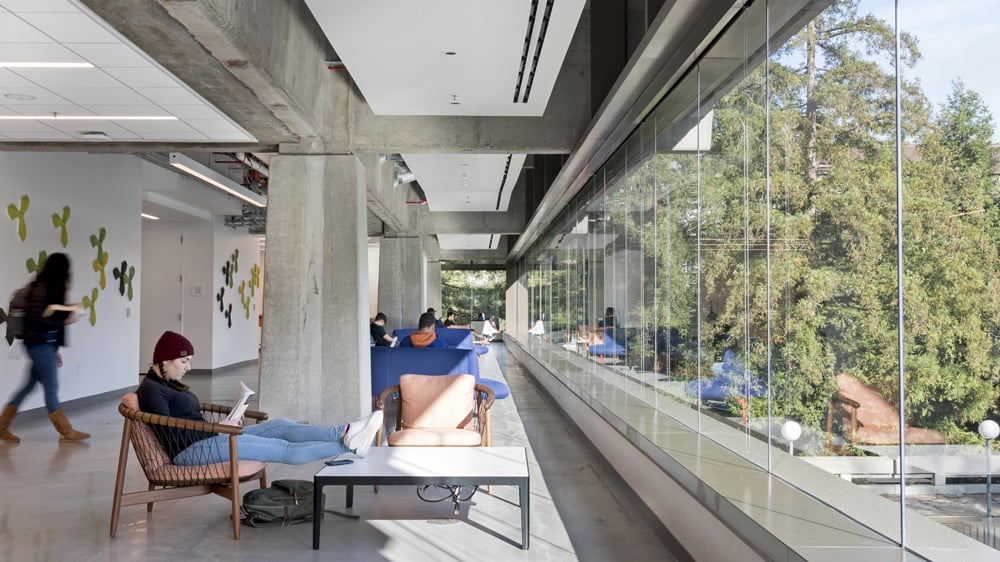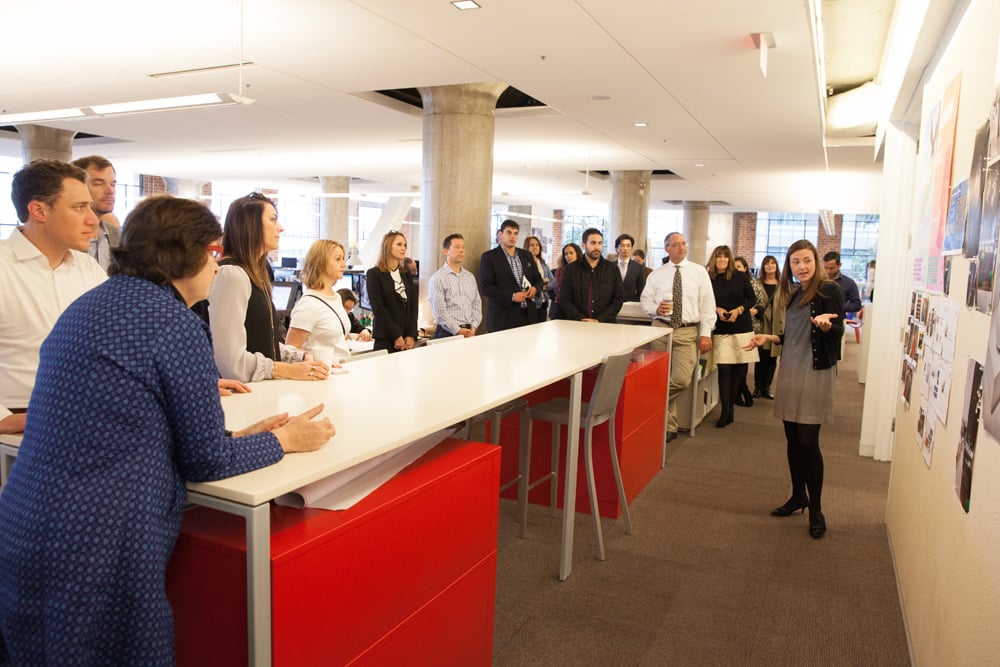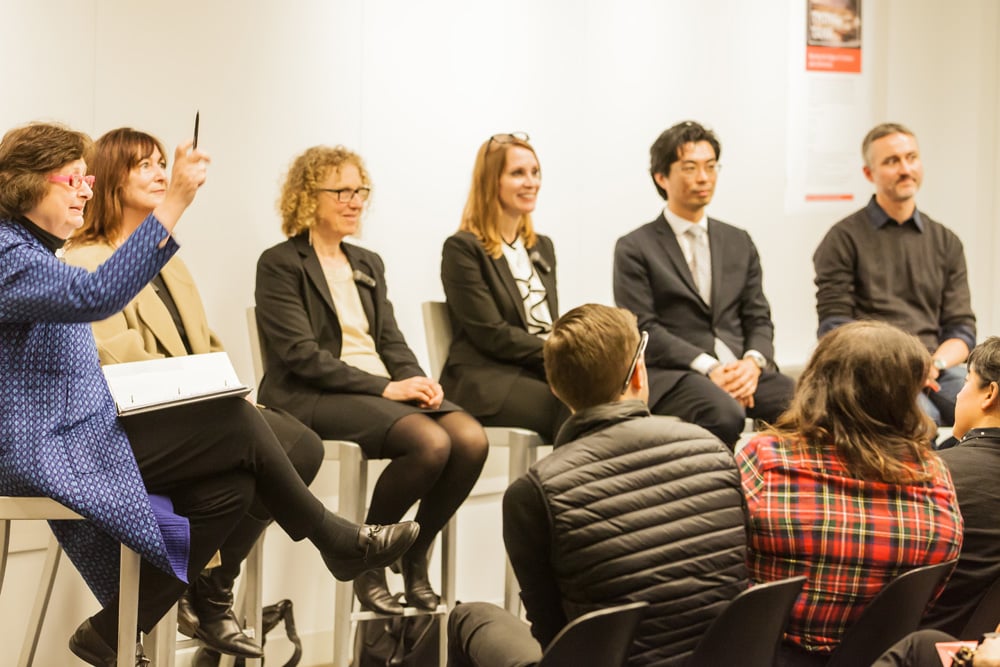
November 30, 2017
Blurring the Edges of Campus and Community
A Q&A with Gensler Architects on fostering community engagement and partnerships between higher education institutions and the public sphere.
For the past three years Metropolis’s director of design innovation Susan S. Szenasy has been leading Think Tank, a series of discussions with industry leaders on important issues surrounding human-centered design. On February 9th, at the Gensler offices in San Francisco, she spoke with a panel of architects and college administrators about the development of constructive partnerships between higher education institutions and the public sphere, and the role of architecture in fostering community engagement. What follows is an edited transcript of the conversation, prepared by M. Nacamulli.
Susan S. Szenasy, director of design innovation, Metropolis Magazine (SSS): There are new standards of flexibility, mobility, and connectivity between academia and social and environmental responsibility. How does this relate to Santa Rosa Junior College?
Dr. Jane Saldana-Talley, vice president in charge of district-wide Institutional Planning and Effectiveness, Santa Rosa Community College (JST): Santa Rosa Junior College serves a full range of needs, from the incumbent worker taking one course to the student completing transfer requirements to the adult pursuing lifelong learning. And after 100 years of service, we are deeply connected with our community. The challenge is staying contemporary, keeping up with our changing demographic, and adapting to student engagement.
SSS: What kind of programs are evolving?
JST: With a local nonprofit organization called Daily Acts that helps people eliminate big lawns and create water-wise environments, we planted a food forest on an entire lawn area. It has not only become a source of food for students, but has also sparked the creation of an adjacent community garden. Daily Acts now brings members of the community to our campus to learn how to turn their yards into productive ecosystems. It’s become a community learning space.
SSS: What is going on at UC Berkeley with community outreach?
Emily Marthinsen, AIA, assistant vice chancellor and campus architect, UC Berkeley (EM): The University of California’s mission is three-fold: instruction, research, and public service. The overlap of these elements, along with the economic development of the local environments, makes it harder to say that any activity, space, or experience associated with the universities is linked to just one thing. Our research agenda, public service, and global engagement are all highly integrated and interdisciplinary now.
SSS: What distinguishes the Wharton School?
Barbara Craft, director of admissions at The Wharton School, University of Pennsylvania (BC): The Wharton School’s primary mission in coming west from Philadelphia was to offer our MBA program to working professionals. Because the program only meets every other weekend, we wanted to provide opportunities to interact and collaborate. We have study rooms throughout the floor, as well as an in-house catering facility with local food. We also offer incubator space from which our alumni can launch their ventures. The space is functional almost 24/7, and we are quickly outgrowing it as it becomes increasingly popular.
SSS: The assignment for the designers and the architects was incredibly detailed to accommodate a variety of groups and functions in one space.
Melissa Mizell, principal, Gensler: To design Wharton, we first toured the University of Pennsylvania campus. We were struck by the spaces between the courtyards. While the program clearly needs classrooms and study rooms, we felt that keeping these open spaces was critical, not just to help students engage with cohorts, but also to adapt to any future repurposing.
SSS: Non-determined spaces seem more problematic than determined ones. How do you approach that as a designer?

Aaron Howe-Cornelison, project architect, Studio Design & Delivery Leader, Gensler (AHC): We need to understand the intentions of the enclosed spaces, then consider how technology and comfort relate. The supporting infrastructure must be invisible to the user for the space to be functional.
We deal with non-determined spaces as delicately as possible. We use materials with immediate metaphor: glass, transparency. As conduits, the middle spaces are where we try to encourage chance encounters and collaboration.
SSS: Can the parameters be manipulated?
AHC: We have to be cognizant of the pragmatic aspects of the lofty ambition: technology constraints, security, and safety. Invisibility ensures that we handle those issues as cleverly as possible.
SSS: With so much activity, there must be a lot of acoustical considerations.
MM: While we love the character of unfinished spaces, in order to provide great acoustics, it can’t be all open. We needed ceilings, carpet, upholstered furniture, and panels on the walls. The parameters become a design tool: a wall panel is an opportunity for color, a ceiling is a chance to play with different heights.
SSS: How do connections between the university campus and town bring together the constituencies of previously segregated areas?

Riki Nishimura, AIA, RIBA, MRAIC, LEED AP BD+C, NCARB, director of urban strategies, Gensler (RN): There are both urban and suburban higher education models. In the urban model, you inevitably deal with your constituencies. In the suburban model, institutions often have their backs to the rest of the community. With the paradigm shift in our thinking in education, it only makes sense for community engagement to start informing the environments we want to be in.
In some urban campuses, the public realm can take place on the campus green. The private and public sectors, as well as higher education, are working together to blur edges and create these new environments.
SSS: You’re talking about increased outreach and collaboration with the town. Does university talent spill over to entrepreneurial businesses around the campus?
EM: Higher education—including community colleges, satellite campuses, and specialty campuses—is generating economic growth and development. The vast majority of higher education entities house innovation hubs, performing arts locations, and consulting businesses. The former self-contained campus has become a physical resource for economic, lifestyle, and cultural activities.
SSS: We live in a porosity where things are really connecting. Yet, there is a culture of fear. How is the security issue, be it psychological or physical, being dealt with?
EM: If the narrative is about fear, it changes the way that we think about our buildings and campus. With Berkeley’s Moffitt Project, Gensler took a 1960’s library building that faced our central glade and created an entryway from the main part of campus. The building is always open and the people inside are connected visually with the people in the landscape. It’s a very powerful statement about the openness of the campus.
SSS: The Moffitt Library is about gathering and connecting. It’s a container of human intelligence – a place for ideas, thinking, and learning. How did you come up with a design that’s so seamless and nonintrusive?
AHC: Safety manifests itself in two ways: real safety and perceived safety. The concept of transparency was very important, and we communicated with security experts to validate our perceptions of how that would work. We need to consider technological solutions, whether a security measure is invasive or too obvious, and how to complement or supplement the goal of thinking and learning.
SSS: Are there architectural moves put in place to make people feel safe?
AHC: In the context of a frightening event – real or perceived – having an alternate means of avoiding or escaping a situation helps to abate fear as quickly as possible. The dead-end is an intimidating space, whereas circulation paths offer a way out.

SSS: What do we learn from urban planning that can help with individual buildings?
RN: It’s important to elevate the environment so everyone feels comfortable and safe in any situation. There are different levels of security, such as perimeter security, veil security, and building security. With our projects, we emphasize visibility. For example, at Civic Center Campus, we used transparency to open up the edges, but we also worked security into the landscape.
SSS: Exposure, landscape, and structure all work together to create an environment of safe passage. With so much of the community attending, community colleges have the benefit of economic and intellectual connectivity.
JST: Our college includes two campuses, a farm, a public safety training center, and a culinary center, as well as another center developing to serve our growing Latino community. It’s an interesting challenge to weave that together because our sites are physically differentiated, but also part of a whole.
We have public access to our instructional environments that connect them, through spaces and events, in ways that are meaningful to the community. We want bring people to a known, safe space and inspire them.
SSS: The idea that we need to understand and connect with our world is interesting for the business community to consider. How does that manifest itself at Wharton?
BC: In our training program for executives, we offer electives in nonprofits, social impact, and ethics. Our students, many of whom come from nonprofits, are actively serving in their communities. We offer global modular courses to study business around the world and have a global consulting practicum so students can have a social impact abroad.
SSS: The word “simultaneity” has been used great deal.
EM: Simultaneity is about holding multiple visions. Higher education has stakeholders with different ages, activities, and values. Architects and planners have to think more broadly about higher education and its relationships to engage outside of our boundaries.
SSS: Let’s talk about connecting to community through job creation. Are the jobs created by universities and startups, elite jobs?
EM: The university is interested in creating jobs for people who may not otherwise have taken that path. There’s interest in using our intellectual capital to think about jobs vertically and increased integration between the four-year colleges and the community colleges.
SSS: In what areas are community colleges supporting the community’s well-being with job availability?
JST: We’re challenged to keep up with changes and create flexible spaces that can be quickly redesigned. In community colleges, the irony of our work is that when the economy is booming, we lose enrollment because are students attend part-time or drop out altogether for work. So, part of it is staying current enough to accommodate incumbent workers or students who have other commitments.
SSS: It’s encouraging that there’s a place to learn a skill that can be quickly applied. Where are architecture and design practices now, and how do they stay up-to-date?
RN: Our approach to projects is a process, which is more important than the product. We cull an urban strategy and think about the elements and forces at play in order to come up with a solution. We also need the equipment, computational skills, and ability to synthesize a lot of information very quickly. In the future of design, we’re analyzing what we learn from community engagement processes and aligning it with our data from other campuses. Often, any anomalies help us reconsider our direction.
It’s not just what we learn in the office or from our education – we are learning from the city itself. New challenges give us the chance to reach out to other disciplines in order to innovate.
SSS: What are some of the key learning points from the Moffitt Project?
AHC: Within today’s ever-expansive complexity, there’s inclusion, which is defiant to a sensibility of fear or uncertainty. We are broadening our mission to include more people, from the secular to the non-secular, from the impoverished to the wealthy.
Expertise needs to be brought in to ensure that inclusion is maintained. And the more that we bring that back to the dollar per square-foot of value for our clients, the better realization we have.
MM: Design is messy. You have to be comfortable with that, and you have to be able to recognize and grow a good idea, no matter whom it’s coming from.
The most important thing that we can instill in design students is the ability to question the given. In some cases, you may be questioning a client’s requests, and that takes guts. But we should strive for the courage to constantly question and the confidence to collaborate.
AUDIENCE MEMBER: The experiential learning team at Minerva focuses on creating experiences in the city for students to apply their learning. What examples have you seen of the integration of education into city life?
EM: At Berkeley, the strategic academic plan stresses the importance for all undergraduates to experience research. Internships have altered how people experience their education and how faculty thinks about where the students do their work.
BC: At Wharton, teams of students with diverse backgrounds help companies with real-life projects. We have also brought in high school students to discuss working in certain industries.
SSS: As a result of connectivity, our lives are richer and we are better designers and educators. I’m very hopeful. I hope you are too.


Panelists:
Barbara Craft, director of admissions at The Wharton School, University of Pennsylvania
Aaron Howe-Cornelison, project architect, Studio Design & Delivery Leader, Gensler
Emily Marthinsen, AIA, assistant vice chancellor and campus architect, UC Berkeley
Riki Nishimura, AIA, RIBA, MRAIC, LEED AP BD+C, NCARB, director of urban strategies, Gensler
Dr. Jane Saldana-Talley, vice president in charge of district-wide institutional planning and effectiveness, Santa Rosa Community College
Moderator:
Susan S. Szenasy, director of design innovation, Metropolis
The Metropolis Think Tank series is presented in partnership with Corian® Design, DXV/GROHE, Shaw Contract, Staples Business Advantage, Sunbrella Contract Fabrics.





